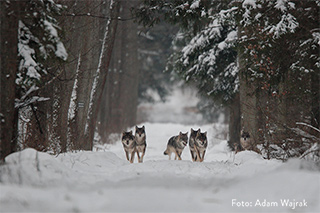Can large predators influence influence deer diet selection in anthropogenic landscapes?
Motivation:
Browsing by herbivores could have severe long-term impacts on the forest structure and composition. These herbivore-plant interactions lead to great discussions between foresters, hunters and conservationists regarding proper ungulate management. Over the last decades, several large carnivores such as the Eurasion lynx (Lynx lynx) and Wolf (Canis lupus) have been expanding their home ranges throughout Germany. In addition, large carnivores are recolonizing ecosystems which have been intensively modified by humans, who can (like large carnvivores) influence the behaviour and spatial distribution of ungulates. A key question emerging from the current recolonization of large carnivores in these human-dominated landscapes is whether and how large carnivores influence their herbivorous prey and if their effects will be strong enough to trickle down to lower trophic levels?
Project aims:
In this project we would like to answer the question; can large carnivores exert nutritionally mediated risk effects on their prey in anthropogenic landscapes? To answer this question, the project is divided into three different steps. First, it will be tested if risk effects of lynx and wolf can influence deer diet selection (browsing intensity and selectivity) and vigilance behaviour of roe- and red deer. Second, it will be tested how risk effects of both large carnivores and human influences (hunting/human settlements) influence spatial patterns of deer foraging and their diet selection. Last, it will be tested whether the effects of large predators change with productivity in Europe.
Study design:
In the first experiment, the influence of large predators will be tested using a free-choice feeding experiment. A total of 44 plots will be set-up, which will be exposed to one of four treatments: a wolf scent, a lynx scent, cow scent (as a control for an unknown no risk scent) and a control treatment with no scent. At each experimental plot, the browsing intensity will be measured and a camera trap will be installed to quantify deer behaviour. The second experiment will be conducted in five different study areas in Germany and Poland, differing in predation pressure on ungulates, and which include hunted and non-hunted areas. In each study area, browsing intensity, selectivity and deer behaviour (using a camera trap) will be measured on a total of 48 transects which are divided in hunted/non-hunted areas and at different distances from human settlements. Further, with the help of the Eurodeer Network, data will made available to test the influence of large carnivores along a productivity gradient in the whole of Europe.
Funding:
- Gregor Louisoder Umweltstiftung, Deutscher Akademischer Austauschdienst
Contact person:
Suzanne van Beeck Calkoen
Doktorandin
suzanne.vanbeeckcalkoen@npv-bw.bayern.de
Prof. Dr. Marco Heurich
Head of department
marco.heurich@npv-bw.bayern.de
Collaborators:
- Dr. habil Dries Kuijper, Mammal Research Institute of the Polish Academy of Sciences
https://www.zbs.bialowieza.pl/ - Nationalparkverwaltung Hainich
https://www.nationalpark-hainich.de/ - Nationalparkverwaltung Schwarzwald
https://www.nationalpark-schwarzwald.de/
Publications:
- Nationalpark Bayerischer Wald lockt Forscher aus der ganzen Welt
https://www.nationalpark-bayerischer-wald.bayern.de/aktuelles/blog/detailansicht.htm?tid=1073956 - van Beeck Calkoen, S. T., Kuijper, D. P., Sand, H., Singh, N. J., van Wieren, S. E., & Cromsigt, J. P. (2018). Does wolf presence reduce moose browsing intensity in young forest plantations? Ecography.



